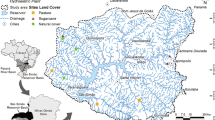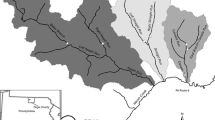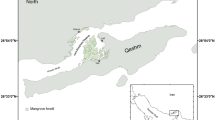Abstract
Multiple stable isotopes were used to determine the effectiveness of distinguishing among several dominant riparian species and aquatic macrophytes both spatially (three sites) and temporally (three seasons) along an 8-km reach of a blackwater stream. The differences in isotopic composition were used to assess contributions of various organic matter sources to the detrital pool of the stream. Samples of riparian and aquatic macrophyte vegetation and detritus were collected at three times to represent early leaf-out (April), mid-summer (August), and just prior to abscission (October). Each sample was analyzed for stable isotopes of carbon δ13C, nitrogen δ15N, and sulfur δ34S Within a site and sampling date, δ13C-values were significantly different among certain riparian species and detritus samples. Species differences persisted between seasons. δ34S values were the most variable of the three elements examined although they remained fairly constant through time within each species and site. The results suggest that temporal changes in isotopic compositions of riparian species and aquatic macrophytes are site-specific. Discriminant analysis dissimilarity plots (based on all three isotopes) demonstrated that the contribution of species to the detrital pool depended on the site and season. At the upper site, detritus was isotopically most similar to Quercus laurifolia and Sparganium americanum in April, and the aquatic macrophytes (S. americanum and Potamogeton spp.) in August and October. At the middle site, detritus was most similar to Carpinus caroliniana and Q. nigra in April but no single source was similar to detritus in August or October. At the lower site, detritus was most similar to Taxodium distichum for all three seasons.
Similar content being viewed by others
References
Benner R, Fogel ML, Sprague EK, Hodson RE (1987) Depletion of 13C in lignin and its implication for stable isotope studies. Nature 329: 708–710
Bunn SE, Barton DR, Hynes HBN, Power G, Pope MA (1989) Stable isotope analysis of carbon flow in a tundra river system. Can J Fish Aquat Sci 46: 1769–1775
Ehleringer JR (1993) Variation in leaf carbon isotope discrimination in Encelia farinosa: implications for growth, competition, and drought survival. Oecologia 95: 340–346
Ehleringer JR, Cooper TJ (1988) Correlations between carbon isotope ratio and microhabitat in desert plants. Oecologia 76: 562–566
Fry B, Joern A, Parker PL (1978) Grasshopper food-web analysis: use of carbon isotope ratios to examine feeding relationships among terrestrial herbivores. Ecology 59: 498–506
Garten CT, Taylor GE Jr (1992) Foliar δ13C within a temperate deciduous forest: spatial, temporal, and species sources of variation. Oecologia 90: 1–7
Haines EB (1977) The origins of detritus in Georgia salt marsh estuaries. Oikos 29: 254–260
Haines EB, Montague CL (1979) Food sources of estuarine invertebrates analyzed using 13C/12C ratios. Ecology 60: 48–56
Kaplin IA, Emery KD, Rittenberg SC (1963) The distribution and isotopic abundance of sulfur in recent marine sediments. Geochim Cosmochim Acta 27: 279–331
Kling GW, Fry B, O'Brien WJ (1992) Stable isotopes and planktonic trophic structure in arctic lakes. Ecology 73: 561–566
Leavitt SW, Long A (1982) Evidence for 13C/12C fractionation between tree leaves and wood. Nature 298: 742–744
Leavitt SW, Long A (1986) Stable-carbon isotope variability in foliage and wood. Ecology 67: 1002–1010
Leff LG, McArthur JV (1988) Seston and dissolved organic carbon transport during storm flows in a natural and a disturbed coastal plain stream. J Freshwater Ecol 4: 271–277
Mihuc T, Toetz D (1994) Determination of diets of alpine aquatic insects using stable isotopes and gut analysis. Am Midl Nat 131: 146–155
Minson DJ, Ludlow MM, Troughton JH (1975) Differences in natural carbon isotope ratios of milk and hair from cattle grazing tropical and temperate pastures. Nature 256: 41–42
Moran MA, Hodson RE (1989) Bacterial secondary production on vascular plant detritus: relationships to detritus composition and degradation rate. Appl Environ Microbiol 55: 2178–2189
Newman MC (1986) Comprehensive cooling water report, vol 2: water quality (Report SREL-28). National Technical Information Service, Springfield, Virginia
Peters KE, Sweeney RE, Kaplin IA (1978) Correlation of carbon and nitrogen stable isotopes in sedimentary organic matter. Limnol Oceanogr 23: 598–604
Peterson BJ, Fry B (1987) Stable isotopes in ecosystem studies. Annu Rev Ecol Syst 18: 293–320
Peterson BJ, Howarth RW, Garritt RH (1985) Multiple stable isotopes used to trace the flow of organic matter in estuarine food webs. Science 227: 1361–1363
Peterson BJ, Howarth RW, Garritt RH (1986) Sulfur and carbon isotopes as tracers of salt-marsh organic matter flow. Ecology 67: 865–874
Pinder JE, Kroh GC (1987) Insect herbivory and photosynthetic pathways in oldfield ecosystems. Ecology 68: 254–259
Puriveth P (1980) Decomposition of emergent macrophytes in a Wisconsin marsh. Hydrobiologia 72: 231–242
Rau GH (1980) Carbon-13/Carbon-12 variation in subalpine lake aquatic insects: food source implications. Can J Fish Aquat Sci 37: 742–746
Rosenfeld JS, Roff JC (1992) Examination of the carbon base in southern Ontario streams using stable isotopes. J N Am Benthol Soc 11: 1–10
Rounick JS, Winterbourn MJ (1986) Stable carbon isotopes and carbon flow in ecosystems. Bioscience 36: 171–177
Rounick JS, Winterbourn MJ, Kaplan IR (1982) Differential utilization of allochthonous and autochthonous inputs by aquatic invertebrates in some New Zealand streams: a stable carbon isotope study. Oikos 39: 191–1988
Rundel PW, Ehleringer JR, Nagy KA (1988) (eds) Stable isotopes in ecological research. Springer, Berlin Heidelberg New York
SAS (1985) SAS user's guide, 1985 edn. SAS Institute, Cary, North Carolina
Stuermer DH, Peters KE, Kaplin IA (1978) Source indicators of humic substances and proto-kerogen. Stable isotope ratios elemental compositions and electron spin resonance spectra. Geochim Cosmochim Acta 42: 989–997
Vannote RL, Minshall GW, Cummins KW, Sedell JR, Cushing CE (1980) The river continuum concept. Can J Fish Aquat Sci 37: 130–137
Webster JR, Benfield EF (1986) Vascular plant breakdown in freshwater ecosystems. Annu Rev Ecol Syst 17: 567–594
Author information
Authors and Affiliations
Rights and permissions
About this article
Cite this article
McArthur, J.V., Moorhead, K.K. Characterization of riparian species and stream detritus using multiple stable isotopes. Oecologia 107, 232–238 (1996). https://doi.org/10.1007/BF00327907
Received:
Accepted:
Issue Date:
DOI: https://doi.org/10.1007/BF00327907




